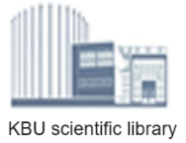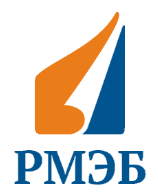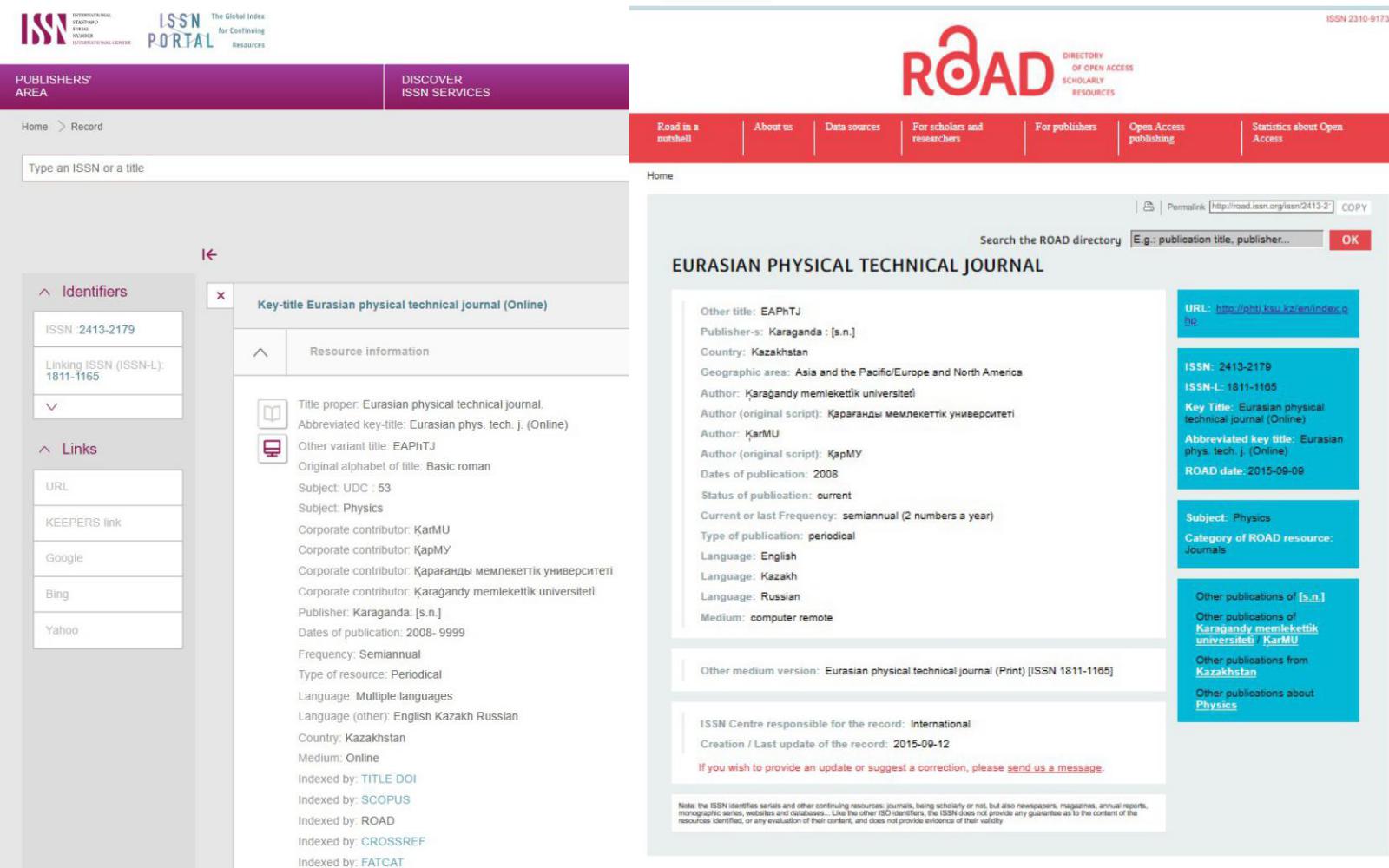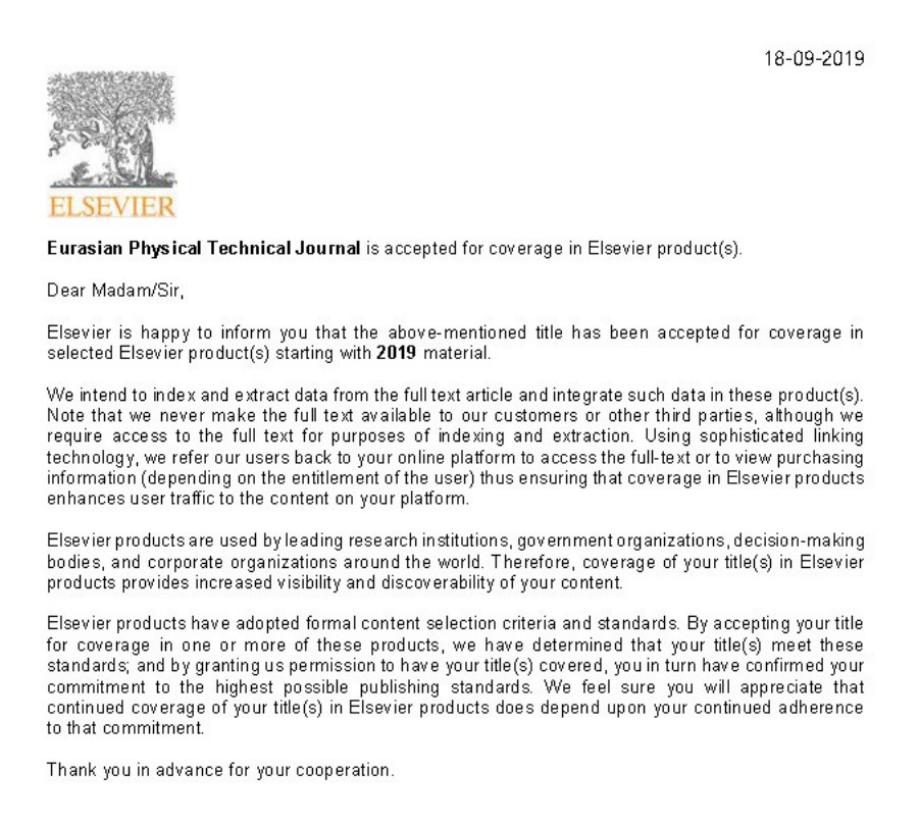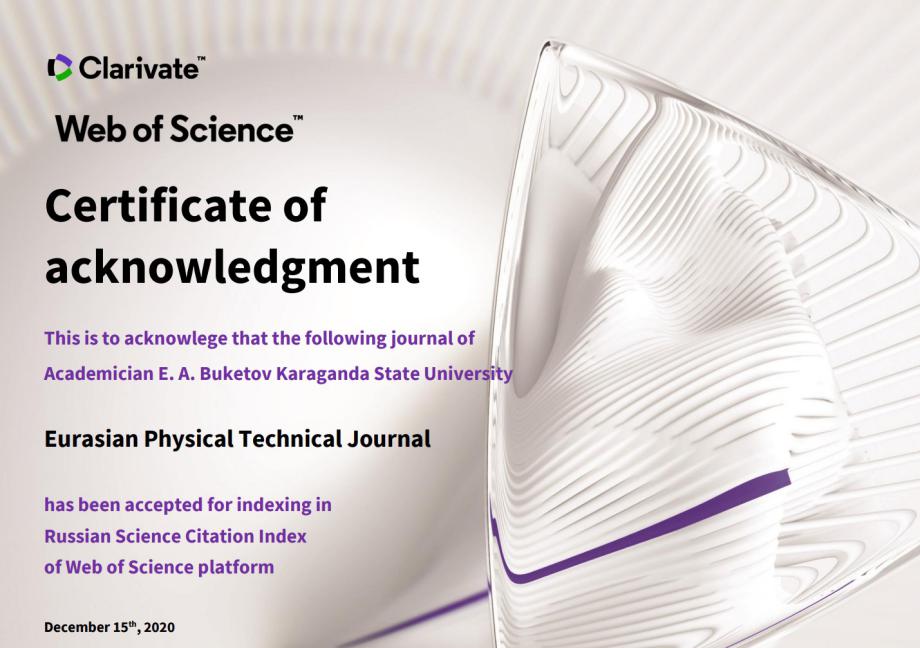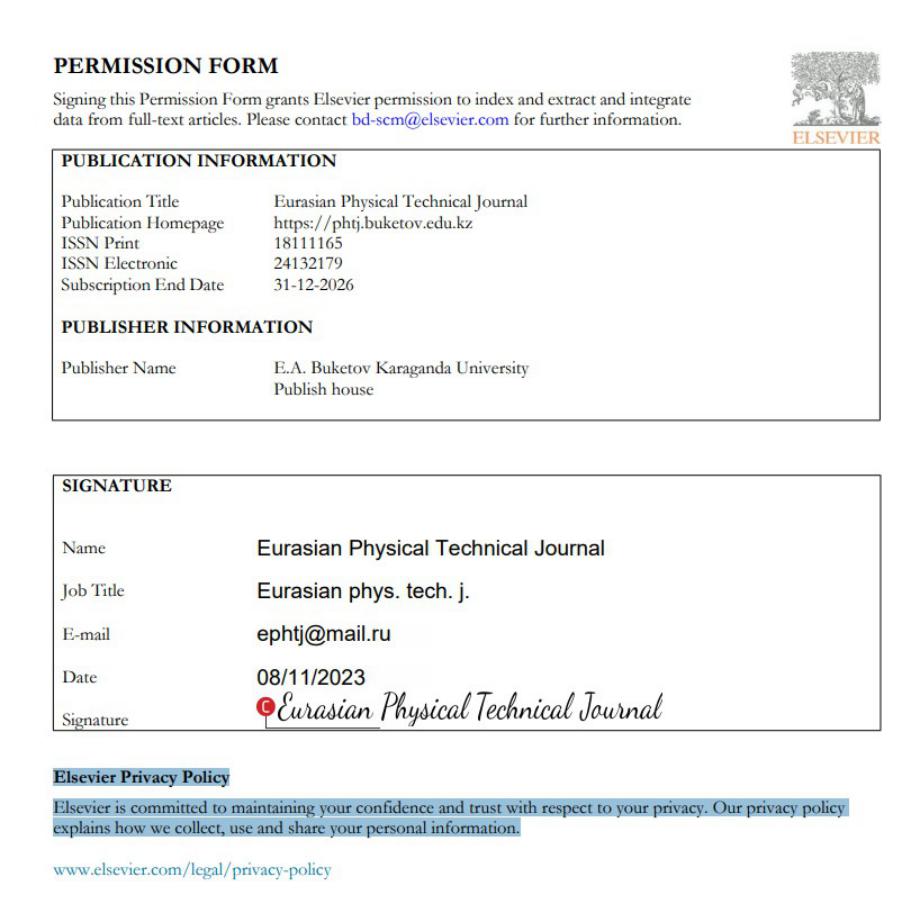Термопластикалық бериллий оксиді керамикасын қалыптау кезіндегі жылу алмасудың әсерін зерттеу
DOI:
https://doi.org/10.31489/2025N1/103-114Кілт сөздер:
ультрадыбыстық белсендіру, бериллий оксиді, термопластикалық шликер, қалыптау процесі, тұтқырлыпластикалық күйАңдатпа
Ультрадыбысты қолдану арқылы түзілетін бериллий оксиді (BeO) керамикасы қарқынды агломерациямен сипатталады және ультрадыбыссыз түзілген керамикамен салыстырғанда, шөгуі және агломерация температурасы төмен болады. Ультрадыбыстық өңдеу кезінде керамиканың агломерациялануын белсендіруге ықпал ететін заттың біркелкілігіне және ұнтақтардың тығыз орналасуына байланысты. Термопластикалық шликердің реологиясының өзгеруі ультрадыбыстың белсендірілуі нәтижесінде жүзеге асты. Белсендіру кезінде пайда болатын өзгерістер дисперсиялық фаза процестерімен және масса алмасуымен байланысты. Ультрадыбыстық белсендіру құймалардың қасиеттерін біршама жақсартады. Құймалардың тығыздығы мен беріктігінің артуы, қатаю кезінде ультрадыбыстың әсерінен шөгудің тиімді азаюымен түсіндіріледі. Яғни құйманың шөгуін өтеу сұйық шликермен толтыру және қысымның әсерінен оның тығыздалуымен анықталады. Термопластикалық бериллий оксиді шликерін ультрадыбыстық құю үшін байланыстырғыш құрамы 10,0 нан 11,7 % дейінгі композицияларды қолданған жөн. Өйткені бұл байланыстырғыш құрамдары бериллий ұнтағымен араласып, беріктігі жоғары шликерге айналып, үлкен температураға шыдамды керамика түзейді.
References
Shakhov S, Bitsoev G. (1999) Application of Ultrasound in the Manufacture of High Thermal Conductivity Ceramic Articles. Ust-Kamenogorsk: EKTU. [in Russian]
Kiiko V, Makurin Yu, Ivanovsky A. (2006) Beryllium Oxide Ceramics: production, physico-chemical properties, application. Yekaterinburg: Ural Branch of the Russian Academy of Sciences. [in Russian]
Shakhov S. (2007) Controlling the deformation behavior of thermoplastic slurries with ultrasound. Glass and Ceramics, 64, 354–356. https://doi.org/10.1007/s10717-007-0088-2
Shakhov S. (2008) Use of ultrasound in order to intensify molding of high-temperature thermocouple sheaths. Refract. Ind. Ceram., 49,261–263. https://doi.org/10.1007/s11148-008-9074-7
Shakhov S, Gagarin A. (2008) Rheological characteristics of thermoplastic disperse systems treated with ultrasound. Glass and Ceramics, 65, 122–124. https://doi.org/10.1007/s10717-008-9030-5
Akishin G, Turnaev S, Vaispapir V., Kiiko V. S., Shein I. R., Pletneva E. D., Timofeeva M.N., Ivanovskii A.L. (2011) Composition of beryllium oxide ceramics. Refractories and Industrial Ceramics, 51, 377–381. https://doi.org/10.1007/s11148-011-9329-6
Akishin G, Turnaev S, Vaispapir V., Gorbunova M.A., Makurin Yu.N., Kiiko V.S., Ivanovskii A. L. (2009) Thermal conductivity of beryllium oxide ceramic. Refractories and Industrial Ceramics, 50, 465–468. https://doi.org/10.1007/s11148-010-9239-z
Zhapbasbayev U., Sattinova Z., Ramazanova G. (2024) Simulation of Hot Casting Shrinkage of Thermoplastic Beryllium Oxide Slurries with Ultrasonic Activation. Engineered Science, 32, 1294. https://doi.org/10.30919/es1294
Sattinova Z.K., Ramazanova G.I., Zhapbasbayev U.K., Assilbekov B.C., Musenova E.K. (2018) Investigation of thermal conditions of the molding process slurry beryllium oxide. Eurasian Physical Technical Journal, 15(2), 30. Available to: https://phtj.buketov.edu.kz/index.php/EPTJ/article/view/528/240
German R, Bose A. (1997) Injection molding of metals and ceramics. New Jersey: Princeton.
Bingham E.C. (1922) Fluidity and Plasticity. New York: McGraw-Hill.
Wilkinson W.L. (1960) Non-Newtonian Fluids. Fluid Mechanics, Mixing and Heat Transfer. London: Pergamon Press.
Pakhomov M.A., Zhapbasbayev U.K., Bosinov D.Zh. (2023) Numerical simulation of the transition of a Newtonian fluid to a viscoplastic state in a turbulent flow. Journal King Saud University Science, 35(2), 102522. https://doi.org/10.1016/j.jksus.2022.102522
Zhapbasbayev U.K., Bekibayev T.T., Pakhomov M.A., Ramazanova G.I. (2024) Heat transfer of crude waxy oil with yield stress in a pipe. Energies, 17, 4687. https://doi.org/10.3390/en17184687
Dvinskikh Yu, Popil’skii R, Kostin L, Kulagin V. (1979) Thermophysical properties of thermoplastic casting slurries of some high-refractory oxides. Ogneupory, 12, 37–4. [in Russian]
Zhapbasbayev U, Ramazanova G, Kenzhaliyev B., Sattinova Z., Shakhov S. (2016) Experimental and calculated data of the beryllium oxide slurry solidification. Appl. Therm. Eng., 96, 593–599. https://doi.org/10.1016/j.applthermaleng.2015.11.114
Sattinova Z., Assilbekov B., Bekenov T., Ramazanova G. (2024) Computational investigation of the influencing parameters on the solidification of thermoplastic beryllium oxide slurry in a cylindrical shell. Ceramics, 7(3), 906-925.https://doi.org/10.3390/ceramics7030059
Voller V, Prakash C. (1987) A fixed grid numerical modeling methodology for convection-diffusion mushy region phase-change problems. Int. J. Heat Mass Transfer, 30, 1709–1719. https://doi.org/10.1016/0017-9310(87)90317-6
Voller V, Swaminathan C, Thomas B. (1990) Fixed grid techniques for phase change problems: a review. Int. J. Numer. Methods Fluids, 30, 875–898.https://doi.org/10.1002/nme.1620300419
Hu H., Argyropoulos S. (1996) Mathematical modeling of solidification and melting: a review. Modelling Simul. Mater. Sci. Eng., 4, 371–396. https://doi.org/10.1088/0965-0393/4/4/004
Moraga N, Andrade M, Vasco D. (2010) Unsteady conjugated mixed convection phase change of power law non-Newtonian fluid in a square cavity. Int. J. Heat Mass Transfer, 53, 3308-3318. https://doi.org/10.1016/j.ijheatmasstransfer.2010.02.044
Carmona M, Cortes C. (2014) Numerical simulation of a secondary aluminum melting furnace heated by a plasma torch. J. Mater. Process. Technol., 214, 334-346. https://doi.org/10.1016/j.jmatprotec.2013.09.024
Bannach N. (2014) Phase Change: Cooling and Solidification of Metal. Available to: https://www.comsol.com/blogs/phase-change-cooling-solidification-metal/
COMSOL Inc. (2014) Available to: http://www.comsol.com/
Chung T. (2002) Computational Fluid Dynamics. Cambridge: Cambridge University Press.
https://doi.org/10.1017/CBO9780511606205
Kiiko V.S., Vaispapir V.Ya. (2014) Thermal conductivity and prospects for application of BeO ceramic in electronics. Glass and Ceramics, 11, 12–16. https://doi.org/10.1007/s10717-015-9694-6
Zhao-Hui R., Xiu-Yan G., Yuan Y., He-Ping T. (2021) Determining the heat transfer coefficient during the continuous casting process using stochastic particle swarm optimization. Case Stud. Therm. Eng., 28, 101439. https://doi.org/10.1016/j.csite.2021.101439
Tannehill J.C., Anderson D.A., Pletcher R.H. (2012) Computational Fluid Mechanics and Heat Transfer, 763. Available to: https://www.iust.ac.ir/files/mech/ayatgh_c5664/files/Computational_Fluid_Mechanics_and_Heat_ Transfer___Anderson__Main_Reference.pdf
Cebeci T., Bradshaw P. (1988) Physical and Computational Aspects of Convective Heat Transfer. https://doi.org/10.1007/978-1-4612-3918-5
Downloads
Жарияланды
How to Cite
Журналдың саны
Бөлім
License

This work is licensed under a Creative Commons Attribution-NonCommercial-NoDerivatives 4.0 International License.


